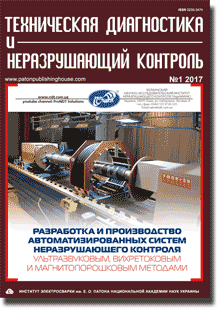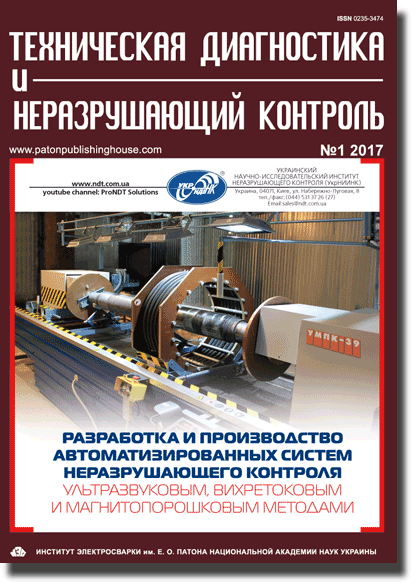| 2017 №01 (10) |
DOI of Article 10.15407/tdnk2017.01.01 |
2017 №01 (02) |

Technical Diagnostics and Non-Destructive Testing, №1, 2017 pp. 5-10
Magnetic method for determination of the thickness of protective concrete layer and diameter of rebars of building structures
Gusev A. P., Shukevich Ya. I., Lukianov A. L.
Institute of Applied Physics of the National Academy of Sciences of Belarus. 220072, Minsk, str. Academic, 16.
E-mail: lab1@iaph.bas-net.by
A magnetic method of determination of the thickness of protective concrete layer and diameter of rebars of concrete building structures is proposed. Computer modeling was used to obtain the distribution of magnetization in a steel rod, and distribution of intensity of magnetic scattering field of the rod at local magnetization by a constant magnet field, depending on rod diameter and its distance to the magnet, was experimentally studied. It is shown that the longitudinal component of rod magnetization, which is characterized by coaxial oppositely directed dipoles, makes a prevailing contribution into the rod scattering field at small dimensions of the magnet. The proposed method is based on measurement of intensity of the rod scattering magnetic field simultaneously in two points above the controlled object surface in the zone of rod magnetization and application of a calibration grid, plotted by the dependencies of the rod scattering field on two determined parameters. A procedure of plotting a calibration grid of measuring instrument for monitoring concrete building structures is shown. 12 References, 2 Tables, 4 Figures.
Keywords: magnetic control method, protective layer of concrete, rebar diameter
References
1. GOST 22904–93. Kon ezobetonnye. Magnitny metod opredeleniya tolshchiny zashchitnogo sloya betona i raspolozheniya armatury. [in Russian].2. EN 1520:2011. Prefabricated reinforced components of lightweight aggregate concrete with open structure with structural or non-structural reinforcement.
3. Ulybin A.V. Inspection methods of reinforcement parameters of concrete structures // Magazine of Civil Engineering. – 2012. – №1 (27). P. 4–13. http://engstroy.spbstu.ru/eng/ index_2012_01/ulybin.html
4. http://www.proceq.com/ru/produkcija/kontrol-betona/lokator-sterzhnei-armatury-v-betone/profometer-pm-600.html
5. http://www.proceq.com/ru/produkcija/kontrol-betona/lokator-sterzhnei-armatury-v-betone/profometer-pm-630-650.html
6. http://www.elcometer.com/images/stories/PDFs/ InstructionBooks/331_b.pdf
7. http://www.proceq.com/ru/produkcija/kontrol-betona/ lokator-sterzhnei-armatury-v-betone/profoscope.html?pqr=5
8. http://www.stroypribor.com/produkt/catalog/naprarm/
9. http://www.tgindt.com/products/concrete-testing-gauge/ time-tc100-tc110-rebar-locator.html
10. Arkadyev V. K. Magnitnye koeffitsiyenty formy, veshchestva i tela / Izbrannye trudy. – M.: Izd. AN SSSR, 1961. – 332 s. [in Russian].
11. Gusev A. P. (2014) Models of Magnetic Charges and Fluxes in the Problem of Flaw Detection with Local Magnetization. Russian Journal of Nondestructive Testing, №6, 343-349 https://doi.org/10.1134/S1061830914060059
12. A. A. Lukhvich at al. (2009) A Magnetic Method for Testing the Thickness of Two-Sided Weakly Magnetic Coatings by a Nonmagnetic Base. Russian Journal of Nondestructive Testing, №7, 502-508. https://doi.org/10.1134/S1061830909070092
The cost of subscription/purchase order journals or individual articles
| Journal/Currency | Annual Set | 1 issue printed |
1 issue |
one article |
| TPWJ/USD | 384 $ | 32 $ | 26 $ | 13 $ |
| TPWJ/EUR | 348 € | 29 € | 24 € | 12 € |
| TPWJ/UAH | 7200 UAH | 600 UAH | 600 UAH | 280 UAH |
| AS/UAH | 1800 UAH | 300 UAH | 300 UAH | 150 UAH |
| AS/USD | 192 $ | 32 $ | 26 $ | 13 $ |
| AS/EUR | 180 € | 30 € | 25 € | 12 € |
| SEM/UAH | 1200 UAH | 300 UAH | 300 UAH | 150 UAH |
| SEM/USD | 128 $ | 32 $ | 26 $ | 13 $ |
| SEM/EUR | 120 € | 30 € | 25 € | 12 € |
| TDNK/UAH | 1200 UAH | 300 UAH | 300 UAH | 150 UAH |
| TDNK/USD | 128 $ | 32 $ | 26 $ | 13 $ |
| TDNK/EUR | 120 € | 30 € | 25 € | 15 € |
AS = «Automatic Welding» - 6 issues per year;
TPWJ = «PATON WELDING JOURNAL» - 12 issues per year;
SEM = «Electrometallurgy Today» - 4 issues per year;
TDNK = «Technical Diagnostics and Non-Destructive Testing» - 4 issues per year.





